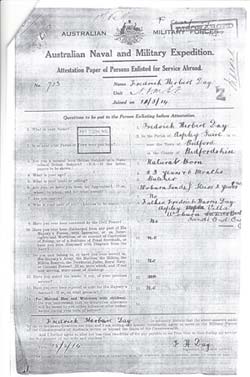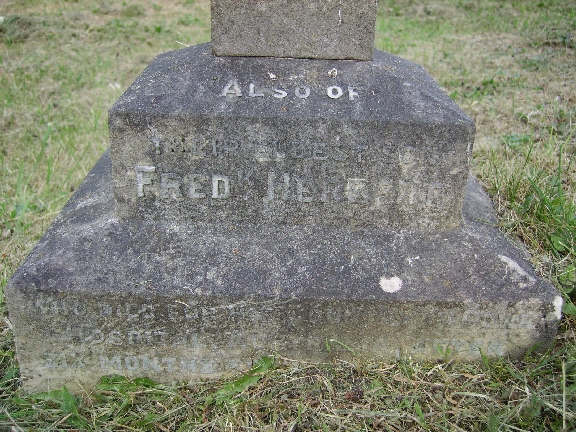PRIVATE FREDERICK HERBERT DAY
Died 7th April 1915
No. 713 of the Australian Naval and Military Expeditionary Force, 1st Battalion, F Company.
Born: Aspley Guise, February 1891
Enlisted: 11th August 1914, Australia
Frederick was the son of Frederick Harris & Emma Day, who is listed on his sons enlistment papers as being late of ‘Aspley Villa’, Woburn Sands, now of Lands End. When Frederick Jnr. enlisted in Australia, he was 23 years and 6 months old. He had been previously been apprenticed to James Steers, a butcher in Woburn Sands, for two years, and was now a butcher in Hawthorn Parade, Haberfield, New South Wales. The medical questionnaire was not completed, but it has been signed “Fit”.
Eight days after his enlistment, he embarked with his unit from Sydney, New South Wales, on board HMAT A35 Berrima to help secure the German-occupied islands to the north of Australia, such as German New Guinea.
I obtained his soldiers file from the Australian Archives, but it contains very little information other than that he was “Discharged” on 18th January, 1915 after 161 days of service. No reason is given, other than “Termination of period of engagement”. He was issued with a 1914/15 Star, British War medal and Victory medal.
However, we learn what had happened from the North Bucks Times of 8th June, 1915:
“Mr. and Mrs. Day, of Brickhill Road, have received news that after an illness of three months, their son, Private Frederick Herbert Day, of the Australian Naval and Military Expeditionary Force, 1st Battalion, F Company, passed away on April 7th 1915 in Cowra District Hospital, New South Wales, Australia. With his occupation being given as “Labourer,” the cause of death was diabetes and exhaustion. At the outbreak of war he had joined the Australian Expeditionary Force, and in his last letter home wrote:
“There were three companies of us set sail, and we landed at a place called Herbertshohe [now Kokopo in Papua New Guinea] one Friday. We marched to the wireless station called Caber Cal. Our officers thought there would be little or no resistance, but they received a shock, as they were ready for us, and gave us a warm time; it was a good thing that they were such bad shots, or there would not have been many of us left to tell the tale. They surrendered, and that was one to us, for we had captured the best wireless station in the South Sea Islands. Afterwards we were on outpost and picket duty for a few hours, and then the alarm went for us to be ready, and about three o’clock the next morning we were marching to a place, Towma, about twelve miles away. We had only marched three miles when the order came to halt, while H.M.A.S. “Encounter” shelled the trenches, and then we marched on again. It was the worst time most of us had, or ever want to have. Our water ran out, and if it had not been for the coconuts and milk, many would have died on the road. We were marching in sand over our ankles, and you can imagine the dust five hundred men would make, with machine guns and a field gun with us. When we arrived there they had surrendered, and we had to march back again. We were back in camp about nine the same night, all dead tired. On the following Saturday we went to Rabaul, about 15 miles up the harbour by boat, where we stopped until November. We went to the Solomon Islands to a place, Keitor, and captured ten prisoners there. There were 52 of us left there, and after about a fortnight we were relieved, and we were on the sea on Christmas Day, in an old tub of a boat, with nothing to eat only bully beef. The Islands were infested with diseases, and it was while we were at Keita I contracted malaria fever. These Islands are called “The White Man’s grave.” When we returned to Rabaul I went into a Hospital and remained there for some time, then was invalided back to Sydney.”
He died in Cowra District Hospital, in New South Wales, with his occupation given as “Labourer”. Cause of death was Diabeties and Exhaustion. It also records he had been sick for 4 months, which ties in with the discharge from the army. Place of birth is given as “Woorbourne Sounds”(!) and his mother as Emily Goodman.
His family obviously considered his a “Death in Service” as on their daughters grave stone at St. Michaels (who had died aged 11, in 1904) they added:
“Also of their eldest son Frederick Herbert, who died for his country in Cowra Hospital Austrailia after 6 months service in Rabaul on April 7th 1915.”
He does not appear on the Commonwealth War Graves index, or on the listings of all UK regimental deaths, but was included in the Buckinghamshire Roll of Honour, which was compiled by parishes sending in lists of their local casualties in 1919.
F. H. Day is listed on the Woburn Sands Memorial. An H. Day appears on the Methodist Memorial.

A brother, Herbert, aged 22, who, having been on the staff of the LS&W Bank, Richmond, Surrey, joined the 17th Service Battalion, Royal Fusiliers, Whytcleafe Camp, Surrey, at Christmas 1914.

I am indebted to the Milton Keynes historian, John Taylor, for supplying the North Bucks Times report.
Page last updated Jan. 2019.
